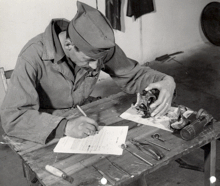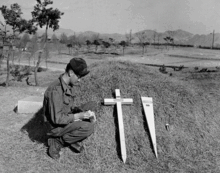- Mortuary Affairs
-
 A soldier from a graves registration unit attempts identification of a skull during World War II
A soldier from a graves registration unit attempts identification of a skull during World War II
Mortuary Affairs is a service within the United States Army Quartermaster Corps tasked with the retrieval, identification, transportation, and burial of deceased American and American-allied military personnel. Until 1991, it was known as the Graves Registration Service (GRS or GRREG).[1] The Graves Registration Service was created several months after the United States entered World War I.
The current Army Military Occupational Specialty for the career field is 92A (a general code for officers across the Quartermaster Corps) and 92M for enlisted personnel.
Contents
Responsibilities
Mortuary Affairs is responsible for retrieval, identification, transportation, and burial of American soldiers. Retrieval can be further subdivided into:
- Combat Recovery — Recovery while combat is still ongoing.
- Post-Combat Recovery — Recovery of the dead immediately after combat has ceased. Danger from mines and enemy snipers is still quite high. Until the 20th century, it was commonplace for combatants to call battlefield truces, in which combatants would temporarily cease fire to allow for the collection of their dead. This practice has ceased in modern warfare.
- Area/Theater Recovery
- Historical Recovery
The role of the Mortuary Affairs service is legally defined in the Uniform Code of Military Justice. (Specifically, it is defined in 10 USC, subtitle A, Chapter 75, Subchapter I, section 1471.[2][3])
Mortuary Affairs has historically been tied with investigation of War crimes. Following World War II, Graves Registration Personnel were instructed to forward all pathological evidence indicating war crimes to the War Crimes Commission.[4]
The Mortuary Affairs Creed is 'Dignity, Reverence, Respect.' [5]
History
Pre-World War I
In the Seminole Wars and Mexican-American War, American soldiers were buried near where they fell, with no effort made to return and little effort made to identify the dead. The American Civil War marked the first time the United States made a concerted effort to identify dead soldiers. General Order No. 33 specified that field commanders were responsible for identification and burial efforts. However, these efforts were not well organized or executed, and were often given low priority. (Commanders were more concerned with winning battles than with the disposition of dead soldiers). After the war, remains of Union soldiers were disinterred and reburied in National Cemeteries.[6]
During the Spanish-American War, the United States initiated a policy of returning soldiers killed on foreign soil back to next-of-kin in the United States, the first country in the world to do so. "Quartermaster General Marshall I. Ludington spoke words that became a harbinger of U.S. retrieval efforts in major world conflicts only a few years later. He said the efforts of the Quartermaster Corps in the Spanish-American War were most likely the first attempt of a nation to "disinter the remains of all its soldiers who, in defense of their country, had given up their lives on a foreign shore, and bring them... to their native land for return to their relatives and friends or their reinternment in the beautiful cemeteries which have been provided by our Government for its defenders."[7]
During the Philippine-American War, the Burial Corps and United States Army Morgue and Office of Identification had overlapping responsibilities for care of the dead.
World War I
 A burial detail from the US 42nd division during World War I, July 30, 1918
A burial detail from the US 42nd division during World War I, July 30, 1918
The Graves registration service was created by General Order #104, issued on August 7, 1917, several months after the United States entered World War I. It consolidated the existing departments into the Graves Registration Service. At its inception, the Graves registration service consisted of the 301st, 302nd, 303rd, and 304th Grave Registration Units. [8] They were deployed to Europe during the war. Many of the men that served in these units had been incapacitated for field service.[9]
World War II
The Graves Registration Service ceased to exist during Interwar period. This led to difficulties reactiviting the service at the beginning of World War II. Despite these initial difficulties, by the end of the war, the Graves Registration service consisted of more than 30 active companies and 11 separately numbered platoons.[8]
At the end of World War II, the Graves Registration service was again effectively disbanded.
Korean War
 A corporal from the Graves Registration Service fills out a Form 52B, giving information regarding a deceased American soldier at the UN Cemetery at Taegu, Korea. At right are (left to right), a cross, an unidentified soldier marker (triangular) and small bottle containing Form 1042 which is buried with the soldier.
A corporal from the Graves Registration Service fills out a Form 52B, giving information regarding a deceased American soldier at the UN Cemetery at Taegu, Korea. At right are (left to right), a cross, an unidentified soldier marker (triangular) and small bottle containing Form 1042 which is buried with the soldier.
The sudden onset of the Korean War caused many problems for the Graves Registration Service. Only one platoon was available in the entire theater. "As the conflict grew in intensity, and deaths of United Nations personnel increased, it became necessary for each combat division to establish and operate its own cemetery, pending the arrival of graves registration companies from the zone of interior to assume this responsibility." The rugged terrain and poor communications further hampered Graves Registration Service activities. Shifts in the momentum of the war meant that it was not uncommon for whole cemeteries to be dug up and moved elsewhere. [10]
Starting on Christmas Day in 1950, the United States made a sweeping change in its policies regarding the handling of soldiers who had been killed in action. Rather than burying them in temporary cemeteries for return at a future date after the conclusion of the war, soldiers killed in action were immediately returned to the United States. This policy, known as concurrent return, remains in effect to this day.[11]
Vietnam
Better transportation, communication, and laboratory techniques allow a higher rate of body identification in the Vietnam War than in previous conflicts. 96% of Americans killed in action were recovered, compared to 78% for both World War II and Korea. By the end of the war, only 28 bodies remained unidentified. All but one of them were identified by 1984, when the last one was interred in the Tomb of the Unknowns.[12] (Using mitochondrial DNA, in 1998 the last unknown was identified as Michael Blassie)
Iraq and Afghanistan
The 54th Quartermaster Company and 111th Quartermaster Company are the Army's only standing, permanent mortuary affairs units.[13] Mortuary affairs training takes place at Fort Lee, Virginia [1], and lasts about seven weeks. These soldiers search areas for hasty or unmarked graves, unburied dead, personal effects, and identification media. They also assist in preparation, preservation, and shipment of remains.
Major Mortuary affairs facilities are the US Army Central Identification Laboratory, in Hawaii (CILHI) and the Charles C. Carson Center for Mortuary Affairs at Dover Air Force Base. The former focuses on identifying remains from the Second World War, Korean War, and Vietnam War, while the latter focuses on more recent conflicts.
Some of those who have volunteered to work with the dead will serve at collection points in Iraq and Afghanistan; others will work in the port mortuary at Dover Air Force Base in Delaware. Another small group will work with the 311th Quartermaster Company from Puerto Rico, a Reserve Mortuary Affairs unit, in Aberdeen, Maryland, at the Joint Personal Effects Depot (JPED). Here, soldiers will receive, inventory, process, clean, filter, and ship all items belonging to deceased or injured soldiers.
The 92Ms have cared for the majority of the more than 4,500 military casualties in Iraq and Afghanistan. They operate under a code of conduct that's part scientific and part symbolic. Using the language of a medical examiner, they fill out forms describing and annotating every wound and marking on the remains they receive. They also "render honors" to each soldier in their care. The 92Ms make sure the deceased travel home feet-first and draped in a flag.
In 2008, the Department of Defense lifted its ban on media coverage (especially photographs) of the return of the bodies of killed service members. Currently, news media may be present if the survivors of the dead give their consent.[14] The ban had been in effect for 18 years, having been instituted in 1991, at the time of the Persian Gulf War.[15] However, the ban was waived on a large number of occasions, to the point that its existence only became widely known in 2004.[16] When the ban was enforced at that time, it was widely criticized as politically-motivated.[17]
Health issues
Studies have shown that mortuary affairs personnel have some of the highest rates of post traumatic stress disorder. "Analysis has revealed three psychological components of handling remains: "the gruesomeness," "an emotional link between the viewer and the remains," and "personal threats to the remains handler."[18] Anecdotal evidence also suggests that those involved with the removal and disposal of war-dead often have to deal with a great amount of psychological pressure later on in their lives, as well as at the time of their duties.[19]
See also
Notes
- ^ Sledge, 43
- ^ Sledge, 13
- ^ U.S. Code collection - Forensic pathology investigations. Cornell University Law School
- ^ Sledge, 10
- ^ Director, Mortuary Affairs Center,"Ode to the Mortuary Affairs Specialist, 03FEBRUARY2011" retrieved 07AUGUST11.
- ^ Sledge, 32-24
- ^ Sledge, 35
- ^ a b William G. Eckert. History of the U.S. Army Graves Registration Service (1917-1950s). American Journal of Forensic Medicine and Pathology, Volume 4, Issue 3. September, 1983. Pages 231-243.
- ^ Major William R. White, Quartermaster Corps. Our Soldier Dead. The Quartermaster Review. May-June 1930. Reproduced by the Army Quartermaster Foundation.
- ^ Lieutenant Commander John C. Cook, Quartermaster Corps. Graves Registration in the Korean Conflict. The Quartermaster Review. March-April 1953. Reproduced by the Army Quartermaster Foundation.
- ^ Sledge, 41
- ^ Dr. Steven E. Anders. With All Due Honors: A History of the Quartermaster Graves Registration Mission. Quartermaster Professional Bulletin, September 1988. Reproduced by the Army Quartermaster Foundation.
- ^ JMAC history. Joint Mortuary Affairs Center. US Army Quartermaster Center and School.
- ^ Randall Chase, "Ban on Photos of War Dead Ends", Express (Washington, D.C.), April 7, 2009, p. 3.
- ^ Randall Chase, "Ban on Photos of War Dead Ends", Express (Washington, D.C.), April 7, 2009, p. 3.
- ^ Alexander Belenky, "Lifting the ban on photographing coffins of US soldiers at Dover is a victory for transparency", The Guardian, February 27, 2009.
- ^ E.g., Foon Rhee, "Political Intelligence: Pentagon ends photo ban on war dead return", The Boston Globe, February 26, 2009; Susan Donaldson James, "Grief for War Dead Shrouds Casket Photo Ban: Military Families Want Sons' and Daughters' Stories Told -- but Privacy Respected", ABC News, February 17, 2009.
- ^ Sledge, 61
- ^ http://www.guardian.co.uk/world/video/2008/oct/13/iraq-war-veterans
References
- Soldier Dead: How We Recover, Identify, Bury, and Honor Our Military Fallen. Michael Sledge. Columbia University Press, 2005, ISBN 0231135149.
External links
Categories:
Wikimedia Foundation. 2010.

